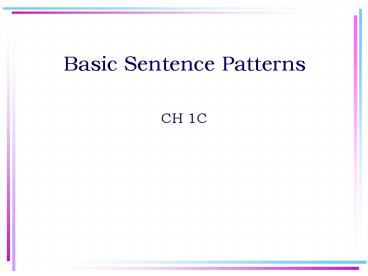Basic Sentence Patterns - PowerPoint PPT Presentation
1 / 10
Title:
Basic Sentence Patterns
Description:
Basic Sentence Patterns CH 1C Basic Sentence Patterns Understanding basic sentence patterns and variations will help you recognize subjects and complements. – PowerPoint PPT presentation
Number of Views:1147
Avg rating:1.0/5.0
Title: Basic Sentence Patterns
1
Basic Sentence Patterns
- CH 1C
2
Basic Sentence Patterns
- Understanding basic sentence patterns and
variations will help you recognize subjects and
complements. The six basic sentence patterns
presented in the following box are based on three
verb types. - You have already been introduced to linking verbs
(such as be, seem, sound, and taste). These verbs
are followed by a subject complement or an
adverbial phrase. Verbs that are not linking are
either transitive or intransitive. - Notice that trans in the words transitive and
intransitive means over or across. - Thus, the action of a transitive verb carries
across to an object, but the action of an
intransitive verb does not. - Intransitive verbs have no complements, although
they are often followed by adverbs or adverbial
phrases.
3
Basic Sentence Patterns
- Pattern 1 Subject Intransitive Verb
- S V S V
ADV - Prices dropped. Prices dropped precipitously.
- Pattern 2 Subject Transitive Verb Direct
Object - S V DO
- He writes detective stories.
4
Basic Sentence Patterns
- Pattern 3 Subject Transitive Verb Indirect
Object Direct Object - S V IO DO
- My father sent me a care package.
- Pattern 4 Subject Transitive Verb Direct
Object Object Complement - S V DO
- The new leaders declared the country
- OC
- a separate nation.
5
Basic Sentence Patterns
- Pattern 5 Subject Linking Verb Subject
Complement - S V SC
- Dr. Vargas is the discussion leader.
- Pattern 6 Subject Linking Verb Adverbial
Phrase - S V Adv. Ph.
- They are in the library.
6
Basic Sentence Patterns
- When declarative sentences, or statements, are
turned into questions, the subject and the
auxiliary verb are sometimes inverted that is,
the auxiliary verb is moved to the front of the
sentence before the subject. - Statement A Chinese skater has won a gold medal.
- Aux S
- Question Has a Chinese skater won a gold medal?
7
Basic Sentence Patterns
- Often, a question word such as what or why opens
an interrogative sentence. As long as the
question word is the object of the sentence, the
auxiliary verb comes before the subject. - Aux S
- Question What has a Chinese skater won?
8
Basic Sentence Patterns
- If a statement does not include an auxiliary verb
or a form of the linking verb be, then a form of
do is added to create the corresponding question.
Once again, the auxiliary verb (in this case, do)
is placed in front of the subject. - Statement A Chinese skater won a gold medal.
- Aux S
- Question Did a Chinese skater win a gold medal?
9
Basic Sentence Patterns
- Other sentences have phrases that are not
essential but do add pertinent information. These
phrases can sometimes be moved. For example, the
phrase on Friday can be placed either at the
beginning or at the end of a sentence. - I finished my assignment on Friday.
- On Friday, I finished my assignment.
10
Thinking Rhetorically AboutSentence Patterns
with Direct Objects
- If you want to intensify a a feeling or emphasize
a contrast, alter the sentence pattern by placing
the direct object at the beginning of the
sentence. A comma is sometimes used after a
direct object in such sentences. - They loved the queen. They despised the king.
- They loved the queen. The king, they despised.
- I acquired English at home. I learned French on
the street. - I acquired English at home. French I learned on
the street.































